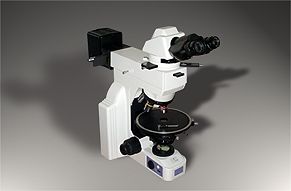 |
The petrographical microscope
What is this kind of microscope? |
|
| Are all the petrographical microscopes identical? There are two main types of microscopes: those using transmitted light and those that uses reflected light (in some models is possible to have the two possibilities in the same apparatus). The transmitted light microscopes, the light source is located under the stage and the light is conducted by several lenses and passes throughout the thin section. The rock samples should be almost transparent in order to be crossed by the light. The microscopes using reflected light the source light is located above the stage and what is observed is the result of the minerals reflecting light. The opaque minerals are observed using this kind of microscope. What are the particularity of these microscopes?
The rotating stage is necessary to observe the characteristics of the minerals in all the directions. What can be observed with the petrographical microscope? Are all the rocks suitable for microscopical observations? |
||